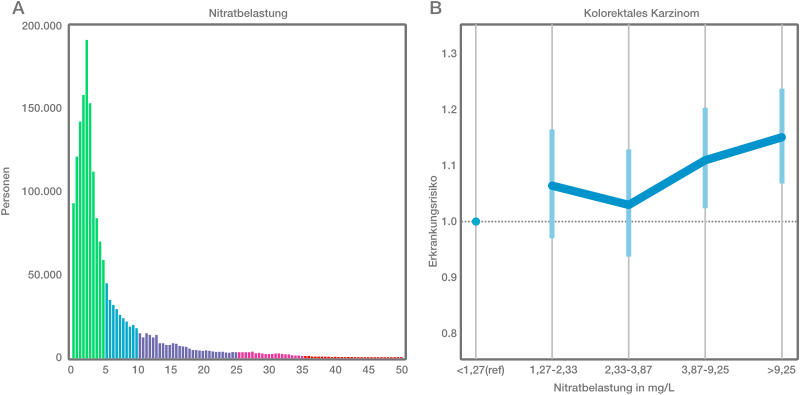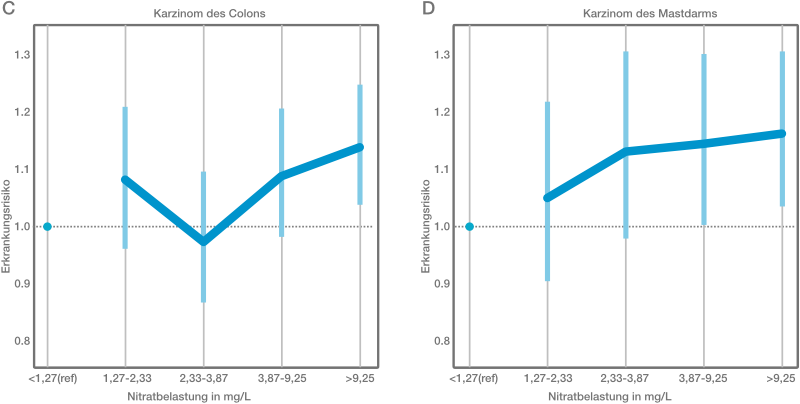The nitrate content
The current limit value for nitrate in drinking water is 50 mg/l according to the German and Austrian Drinking Water Ordinance and in most European countries, and 40 mg/l according to the Swiss Water Protection Ordinance.
Water suppliers are obliged to comply with these limits.
Nitrate value breakdown in Germany (as at 6/2024))
Based on the different areas shown in colour on the map, the current distribution of nitrate values for Germany is as follows:
This means that drinking water currently has low nitrate levels for over 70% of the population and, according to the Federal Office for Risk Assessment, is also suitable for the preparation of infant formula. Für 30% allerdings nicht.
If you want to know what this looks like in your area, first check whether your city is included in our database. Simply enter your postcode or town name in the search field.
If your city is included, you can also see when the data was last updated by us. On our map you can also view the nitrate content for each location.
What are nitrates and where do they occur?
Nitrates are water-soluble salts of nitric acid. Many soils today are poor in nitrogen and are therefore fertilised in agriculture with liquid manure and nitrogenous mineral fertilisers. Liquid manure is an organic nitrogen compound. These are converted from ammonium ions (NH4+) via the intermediate stage nitrite to nitrate by nitrification in the soil or in bodies of water with the help of bacteria. Mineral fertilisers usually consist of ammonium, calcium, sodium or potassium nitrate. The nitrate is absorbed by the roots of the plants.
Where are measurements taken?
The water supply companies monitor drinking water quality very closely. The nitrate content in particular has recently become the focus of attention. The measurement sites at which a significantly elevated nitrate value was detected in the groundwater, are (very deliberately) located several hundred metres to several kilometres away from the actual wells from which the drinking water is extracted. The measurements thus serve as advance warnings to give the responsible authorities enough time to initiate countermeasures.
What are the risks?
According to recent scientific findings, health concerns about excessive nitrate intake from food relate primarily to the possible nitrate-nitrite-nitrosamine reaction chain.
On the one hand, such a conversion takes place in the intestine by corresponding bacteria. On the other hand, the salivary glands can also reduce nitrate that has accumulated in the bloodstream. The intestinal flora of an infant (like the intestinal flora of an adult) can contain nitrite-forming bacteria.
Nitrosamines have been shown to cause cancer (carcinogenic) in animal experiments.
Krebserkrankungen und Geburtsschäden
American studies of 16,000 women in Iowa found evidence of an increased risk of cancer of the bladder, ovaries, kidneys and thyroid. Other studies in Texas and Iowa have found evidence of an increased risk of birth defects - cleft palate and spina bifida - in newborns whose mothers drank drinking water with nitrate levels of more than 5-6 mg/l during pregnancy.
Another recent study by Dr Jörg Schullehner from the University of Aarhus in Denmark with around 1.7 million participants over a period of more than 30 years (1978 - 2011) found a direct link between the risk of developing bowel cancer and the nitrate content of drinking water: participants who were exposed to more than 16 mg/l nitrate over the entire period of the study had an almost 20 per cent higher risk of bowel cancer than those who had ingested less than 0.7 mg/l nitrate via their drinking water.
Further information can be found on our sources page.


B: Statistical risk assessment for colorectal cancer in general (colorectal carcinoma) for this study population
C: Statistical risk assessment for the large intestine without rectum (colon) for this study population
D: Statistical risk assessment for the rectum for this study population
The authors of the study emphasise that it is particularly worrying that an increase in risk was already recorded at nitrate concentrations that are well below the legally prescribed limits, which is why it makes sense to consider reducing the drinking water limits, regardless of the fact that the issue requires further studies.
A recent case-control study from Spain and Italy showed that the higher the intake of nitrate from drinking water, the higher the risk of bowel and rectal cancer, even at levels far below the limit permitted for drinking water.
Infant cyanosis
Another risk for infants is the oxidation of haemoglobin to methaemoglobin by the nitrite produced. Haemoglobin is a protein that is found inside the red blood cells and is responsible for transporting the oxygen inhaled through the lungs to the cells.
A natural enzyme reaction reduces most of the methaemoglobin back to haemoglobin, a natural cycle that does not yet function properly in infants as they do not yet have a fully developed reduction capacity.
However, if this reduction does not take place and the dysfunctional methaemoglobin cannot deliver oxygen to the tissue cells, there is a risk of internal suffocation, which can be recognised by a purple to bluish discolouration of the skin, mucous membranes, lips and fingernails. Babies up to the age of 6 months are particularly susceptible to this infant bluetongue.
What does this mean for infants?
The acceptable daily intake (ADI) of nitrate (NO3-) recommended by the World Health Organisation is 0-3.7 mg/kg body weight.
The German Federal Office for Risk Assessment (BfR) has made the following calculation:
| Age | Median* | P 95** | Max*** |
|---|---|---|---|
| 3 month | 5,4 | 7,4 | 8,0 |
| 6 month | 3,3 | 5,0 | 5,5 |
| 9 month | 2,3 | 4,7 | 10,0 |
| 12 month | 1,6 | 4,2 | 8,8 |
Daily nitrate intake (mg/kg body weight) of infants whose formula food was prepared with drinking water below the applicable maximum level of 50 mg/l
* Median = 50. Percentil, average body weight in this age group
** P95 = 95. Percentil, only 5% in this age group weigh more
*** Max = Observed maximum value in this age group
This means that the maximum permissible nitrate intake is still significantly exceeded for 6-month-old infants and even several times higher for 3-month-old infants. For 3-month-old infants, the nitrate content should therefore be a maximum of 23 mg/l, for a 6-month-old infant 33 mg/l, in order to comply with the maximum permissible intake, if the respective maximum value of the age group is used. This always assumes that no fruit or vegetables are added to the diet.
Older children from the age of 6 months are no longer at risk of infant blues. However, the carcinogenic nitrosamines pose a great risk here, especially because it can be assumed that fruit and vegetables begin to be added at this age.
The BfR has made the following calculation for a maximum quantity of 250 mg nitrate/kg ready-to-eat food in a 200 gram jar with 100 grams of vegetables as stipulated in the Dietary Guidelines:
| Age | ADI-valuet |
|---|---|
| 12 month (9,5 – 10,3 kg body weight) | 5,3 – 4,8 mg/kg body weight |
| 18 month (10,9 – 11,8 kg body weight) | 4,6 – 4,2 mg/kg body weight |
| 24 month (12,3 – 13,1 kg body weight) | 4,1 – 3,8 mg/kg body weight |
| The same calculation for a maximum quantity of 150 mg nitrate/kg in a 200 gram jar: | |
| 12 month (9,5 – 10,3 kg body weight) | 3,2 – 2,9 mg/kg body weight |
| 18 month (10,9 – 11,8 kg body weight) | 2,8 – 2,5 mg/kg body weight |
| 24 month (12,3 – 13,1 kg body weight) | 2,4 – 2,3 mg/kg body weight |
Daily nitrate intake (mg/kg body weight) of infants whose body weight corresponds to the average (median) in the respective age group.
From this it is easy to see that the ADI value of 3.7 mg/kg body weight can hardly or not at all be complied with as long as ready-made food with a lower nitrate content of a maximum of 150 mg nitrate/kg is not used.
In 1986, the German Federal Health Office therefore recommended that a nitrate limit of 10 mg/l in drinking water should not be exceeded for the preparation of infant formula. Assuming that 12-month-old children only consume 100 grams of vegetables as supplementary food, the ADI of 3.7 mg/kg bw would not be exceeded with a nitrate intake of 10 mg/l water (for a child with an average body weight corresponding to its age group) and a maximum quantity of 150 mg nitrate/kg supplementary food.
Humans ingest nitrate not only through drinking water, but also, for example, through various vegetables with a naturally high nitrate content (rocket and other leaf lettuces, spinach, kohlrabi, beetroot, radishes and radishes). Particular attention should therefore be paid to the nitrate content of drinking water, especially for children and older people who suffer from bacterial gastrointestinal infections.